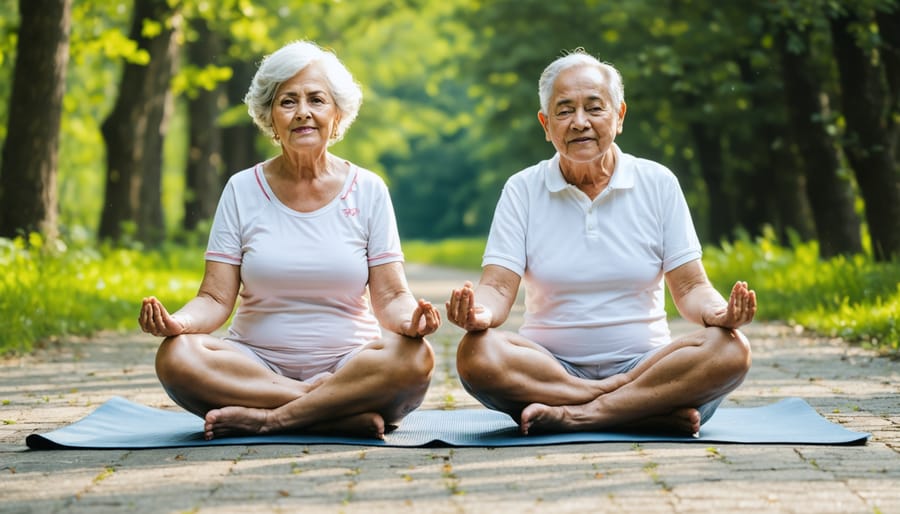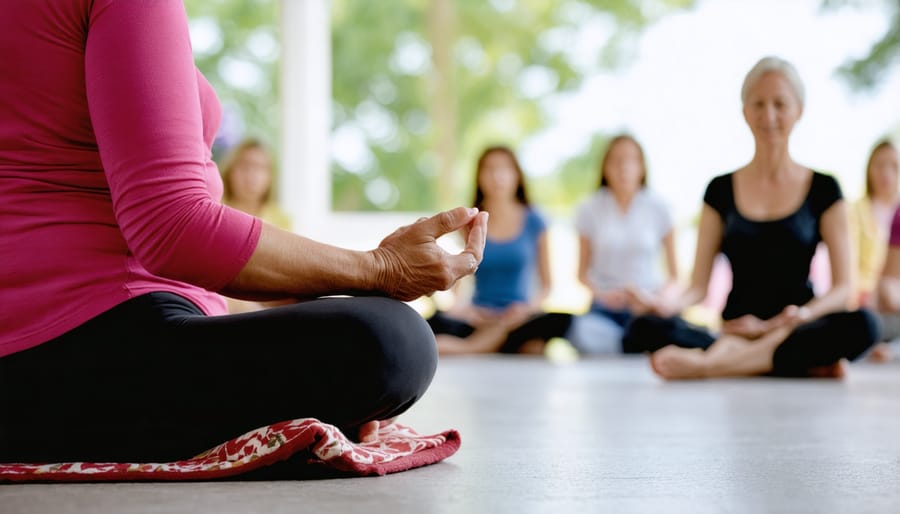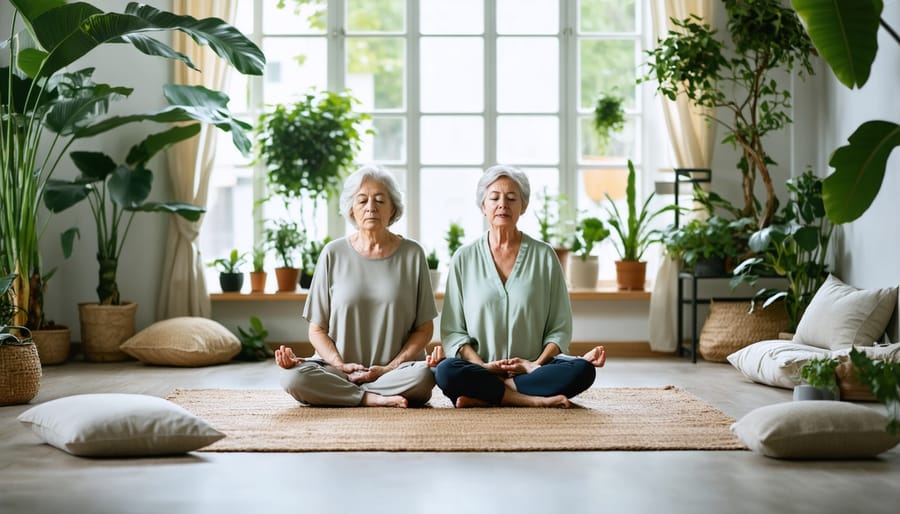Transform senior care by embracing a whole-person wellness approach that combines natural healing practices with modern medical knowledge. Integrate meditation, gentle movement, and social connection into daily routines to enhance cognitive function and emotional well-being. Support aging bodies through nutrient-dense, whole foods, therapeutic herbs, and targeted supplements that address specific health concerns. Create healing environments that promote independence while incorporating safety features, natural light, and spaces for both solitude and community engagement.
Holistic senior care recognizes that optimal aging extends beyond medical treatments to encompass mental, emotional, and spiritual wellness. This integrated approach reduces medication dependence, improves quality of life, and empowers seniors to maintain their autonomy. By addressing root causes rather than just symptoms, holistic care provides a sustainable framework for healthy aging that honors each individual’s unique needs and preferences.
Traditional wisdom combined with evidence-based practices offers seniors a comprehensive pathway to vitality. From acupuncture and massage therapy to mindfulness practices and nutritional counseling, these natural approaches complement conventional medical care while minimizing side effects and promoting overall wellness.
The Mind-Body Connection in Senior Health
Mental Wellness Practices
Mental wellness is a crucial component of holistic senior care, significantly impacting emotional well-being in seniors. Regular meditation practice, even just 10 minutes daily, can help reduce anxiety, improve sleep quality, and enhance overall mental clarity. Simple mindfulness exercises, such as focused breathing or gentle body scanning, can be particularly beneficial for seniors who may have mobility limitations.
Cognitive exercises play an equally important role in maintaining mental sharpness. Activities like crossword puzzles, reading, learning a new language, or playing musical instruments help stimulate neural pathways and maintain cognitive function. Social engagement through group activities, such as book clubs or discussion groups, combines cognitive stimulation with valuable social interaction.
Many Canadian seniors find success with guided meditation apps or community programs specifically designed for older adults. These resources often incorporate age-appropriate visualization techniques and gentle mental exercises that can be practiced while seated or lying down. The key is consistency and finding activities that bring both enjoyment and mental engagement.
Physical Activity’s Impact on Mental Health
Regular physical activity plays a vital role in maintaining mental health and emotional well-being for seniors. Research shows that even moderate exercise, such as daily walking or gentle stretching, can significantly reduce symptoms of anxiety and depression while boosting overall mood through the release of endorphins.
Exercise helps seniors maintain cognitive function by increasing blood flow to the brain and promoting the growth of new neural connections. Studies indicate that seniors who engage in regular physical activity have better memory retention and problem-solving abilities compared to their sedentary counterparts.
Group exercise classes offer additional mental health benefits by providing social interaction and community engagement. Activities like tai chi, yoga, or swimming can help reduce feelings of isolation while improving balance and flexibility. These movement-based practices also incorporate mindfulness elements, which can help reduce stress and promote emotional regulation.
For optimal results, seniors should aim for a mix of aerobic activities, strength training, and balance exercises. Even light physical activity, when done consistently, can lead to improved sleep quality, reduced stress levels, and a more positive outlook on life.

Nourishing Body and Spirit

Wholesome Nutrition for Aging Adults
Proper nutrition plays a vital role in maintaining health and vitality during the aging process. Understanding mind-body nutrition benefits can help seniors make informed dietary choices that support their overall wellbeing.
Aging adults should focus on consuming nutrient-dense foods rich in essential vitamins and minerals. Protein becomes particularly important, as it helps maintain muscle mass and strength. Good sources include lean meats, fish, legumes, and dairy products. Calcium and vitamin D are crucial for bone health, while B12 supports cognitive function and energy levels.
Fiber-rich foods like whole grains, fruits, and vegetables help maintain digestive health and regulate blood sugar levels. These foods also provide antioxidants that protect against cellular damage and support immune function. Omega-3 fatty acids, found in fatty fish and nuts, contribute to heart and brain health.
Staying hydrated is essential, as the sensation of thirst often decreases with age. Seniors should aim to drink water throughout the day, even when not feeling thirsty. Some may need to modify food textures or use adaptive eating tools to make meals more manageable.
Consider working with a registered dietitian to create a personalized nutrition plan that accounts for individual health conditions, medications, and dietary restrictions. Small, frequent meals may be easier to manage than large portions and help maintain stable energy levels throughout the day.
Spiritual and Social Wellness
Maintaining strong social connections and nurturing spiritual well-being are essential components of holistic senior care. Research shows that seniors who remain socially active and engaged in their communities experience better mental health, reduced risk of depression, and improved cognitive function.
Community involvement can take many forms, from participating in local seniors’ groups to volunteering at charitable organizations. Regular social activities, such as book clubs, exercise classes, or hobby groups, provide opportunities for meaningful interaction and continued learning. These connections help combat isolation and create a support network that contributes to overall wellness.
Spiritual practices, whether through organized religion or personal reflection, offer comfort and purpose during the aging process. Activities like meditation, prayer, or mindfulness exercises can help seniors manage stress, find inner peace, and maintain emotional balance. Many seniors find that exploring their spirituality helps them cope with life changes and provides a framework for understanding their place in the world.
Family caregivers can support spiritual and social wellness by:
– Helping seniors maintain regular attendance at religious services or community events
– Facilitating video calls with distant family members
– Arranging transportation to social gatherings
– Creating opportunities for intergenerational activities
– Supporting participation in meditation or prayer groups
Remember that spiritual and social needs are deeply personal, and it’s important to respect each individual’s preferences and beliefs while encouraging meaningful connections that enhance their quality of life.
Natural Approaches to Common Senior Health Concerns

Sleep and Relaxation Techniques
Quality sleep is essential for seniors’ physical and mental well-being, and natural approaches can significantly improve sleep patterns. Establishing a consistent bedtime routine helps signal to the body that it’s time to wind down. This might include gentle stretching, reading a book, or practicing holistic stress management techniques like deep breathing exercises.
Creating an optimal sleep environment is crucial. Keep the bedroom cool, dark, and quiet, using blackout curtains or white noise machines if needed. Natural sleep aids such as chamomile tea, lavender essential oil, or magnesium-rich foods can promote relaxation without the side effects often associated with sleep medications.
Mindfulness meditation and gentle yoga before bedtime can help calm an active mind and release physical tension. Seniors should avoid screens at least an hour before bed, as blue light can interfere with natural melatonin production. Regular exposure to natural daylight, especially in the morning, helps regulate the body’s internal clock.
For those experiencing sleep difficulties, keeping a sleep diary can help identify patterns and triggers affecting sleep quality. This information can be valuable when discussing sleep concerns with healthcare providers and developing personalized solutions that align with a holistic approach to wellness.
Pain Management Through Alternative Therapies
Alternative therapies offer effective ways to manage chronic pain without relying solely on medication. For seniors experiencing ongoing discomfort, gentle movement practices like tai chi and yoga can help improve flexibility and reduce joint pain. These low-impact exercises are particularly beneficial as they combine physical movement with mindfulness, promoting both pain relief and relaxation.
Acupuncture has shown promising results in managing various types of chronic pain, including arthritis and lower back discomfort. This traditional Chinese medicine practice involves the insertion of thin needles at specific points to stimulate natural pain-relieving responses in the body.
Massage therapy can be particularly beneficial for seniors, helping to ease muscle tension, improve circulation, and reduce pain associated with conditions like fibromyalgia. Different techniques, from gentle Swedish massage to targeted therapeutic massage, can be adapted to meet individual needs and comfort levels.
Heat and cold therapy remain simple yet effective methods for pain management. Warm compresses can help relax tense muscles and improve blood flow, while cold packs can reduce inflammation and numb acute pain. These treatments can be easily incorporated into daily routines.
Other beneficial practices include meditation and breathing exercises, which help manage pain perception and reduce stress-related tension. Aromatherapy, using essential oils like lavender or peppermint, can also provide complementary pain relief when used safely and appropriately.
Remember to consult healthcare providers before starting any new pain management approach to ensure it’s suitable for individual health conditions and circumstances.
Creating a Holistic Care Plan
Assessment and Goal Setting
A comprehensive assessment of a senior’s current health status is the foundation of effective holistic care. This process begins with evaluating multiple aspects of well-being, including physical health, emotional state, cognitive function, social connections, and daily living activities. Working with healthcare providers, seniors and their caregivers should document existing health conditions, medication usage, dietary habits, and activity levels.
During the assessment phase, it’s important to consider both strengths and areas needing improvement. This might include evaluating mobility, balance, vision, hearing, and social engagement levels. Mental health screening and cognitive assessments can provide valuable insights into emotional well-being and memory function.
Once the assessment is complete, the next step is setting realistic, achievable goals. These goals should be specific, measurable, and time-bound. For example, instead of a vague goal like “become more active,” set a concrete target such as “walk for 15 minutes three times per week.” Goals should address various aspects of wellness, including physical activity, nutrition, social engagement, and mental stimulation.
Consider breaking larger goals into smaller, manageable steps. This approach helps prevent overwhelm and provides regular opportunities to celebrate progress. Regular monitoring and adjustment of goals ensure they remain appropriate and challenging without being discouraging.
Remember that goal-setting should be a collaborative process involving the senior, family members, and healthcare providers. This ensures goals are both meaningful to the senior and medically appropriate. Regular reviews – typically every three to six months – allow for adjustments based on progress and changing needs, keeping the care plan dynamic and responsive.
Integrating Different Wellness Practices
Creating a well-rounded holistic care routine involves thoughtfully combining different wellness practices to support seniors’ physical, mental, and emotional needs. Start by establishing a daily routine that incorporates gentle movement, such as morning stretches or a short walk, followed by mindfulness practices like meditation or deep breathing exercises.
Consider scheduling activities in a way that complements natural energy levels throughout the day. For example, engage in more active pursuits like gardening or exercise classes in the morning when energy is typically higher, followed by relaxing activities like art therapy or music appreciation in the afternoon.
Nutrition plays a crucial role in supporting other wellness practices. Plan meals that incorporate anti-inflammatory foods and herbs that can enhance the benefits of physical activities and support mental clarity. Herbal teas can be integrated into relaxation routines, while protein-rich snacks can support exercise recovery.
Social elements can be woven throughout these practices by joining group activities, participating in community gardens, or attending wellness classes designed for seniors. This social integration helps maintain motivation and provides emotional support while pursuing holistic health goals.
Create a balanced weekly schedule that might include:
– Monday: Gentle yoga and meditation
– Tuesday: Nature walk and art therapy
– Wednesday: Group exercise and social tea time
– Thursday: Massage therapy and mindfulness practice
– Friday: Dance class and garden therapy
Remember to adjust activities based on individual capabilities and preferences, and always consult healthcare providers before starting new wellness practices. The key is finding a sustainable combination that brings joy and promotes overall well-being.
Embracing holistic senior care represents a comprehensive approach to aging that honors the whole person – body, mind, and spirit. By integrating various natural healing practices with conventional medical care, seniors can experience enhanced well-being and a better quality of life during their golden years.
Throughout this article, we’ve explored how nutrition, physical activity, mental health support, social engagement, and alternative therapies work together to create a balanced approach to senior wellness. The evidence shows that when we address all aspects of health simultaneously, seniors often experience better outcomes than with traditional medical care alone.
Implementation of holistic care practices doesn’t have to be overwhelming. Start with small steps, such as incorporating gentle exercise into daily routines, practicing mindfulness, or adding more nutrient-rich foods to meals. Remember that every positive change, no matter how small, contributes to overall wellness.
For caregivers and family members, supporting holistic senior care means being present, patient, and proactive in helping seniors maintain their independence while ensuring their diverse health needs are met. Consider working with healthcare providers who understand and support holistic approaches, and don’t hesitate to explore different therapeutic options that align with your loved one’s values and preferences.
By embracing holistic senior care, we can help create a more fulfilling and dignified aging experience that celebrates the wisdom and vitality of our senior population while supporting their complete well-being.

